DNA
Deoxyribonucleic Acid
:max_bytes(150000):strip_icc()/3-D_DNA-56a09ae45f9b58eba4b20266.jpg)
DNA is the code of life!
It is what makes you you and a dog a dog.
What is it?
It is just two sequences of nucleic acids (chemicals) linked together by a sugar backbone and connected to the other strand in a helix. Take a look:

There are just four "letters" in the "alphabet" of life:
Adenine, Thymine, Cytosine, and Guanine. And their shapes make it so that they always bind the same way: A to T and C to G
Here is a short video on the structure of DNA I made years ago.
Write the base that would bind to this sequence in your notebook:
ATTATTCGTAGGCTAAGTCCTAGGATA
You see in that image that there is a similar compound called RNA. Some things use RNA for their genetic code. Is stands for Ribonucleic Acid. The difference is that DNA is missing an oxygen (hence the "deoxy" prefix) and that makes it need a second strand. RNA is stable enough on its own that it floats around single stranded.
We use RNA for transcription and translation, but those will come later.
Here is another image of DNA:
The purple pentagons are the sugar ribose. That makes the backbone. Coming off it are the A, T, C, and Gs.
DNA is awesome in that it can make a copy of itself (mitosis). How?
When the right cue tells it to, it unzips into two strands of complementary base pairs. Since the T on one strand want to bind with an A and the A on the other strand wants to bind with a T, bases floating around the cell bind and the one unzipped strand becomes two copies. Take a look:
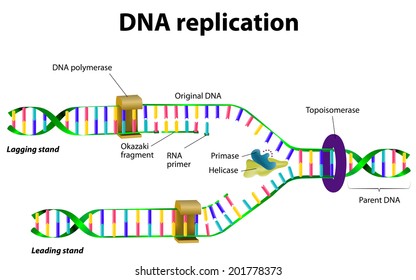
Don't worry about all those part names. Just notice that the helix gets pulled apart and new bases bind making two strands.
Here is another image:
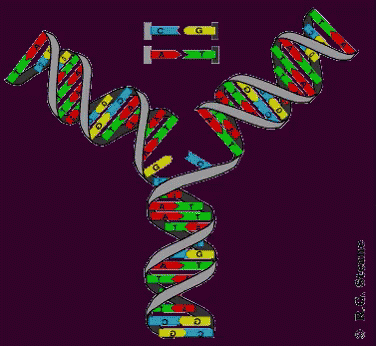
One last one (moving):
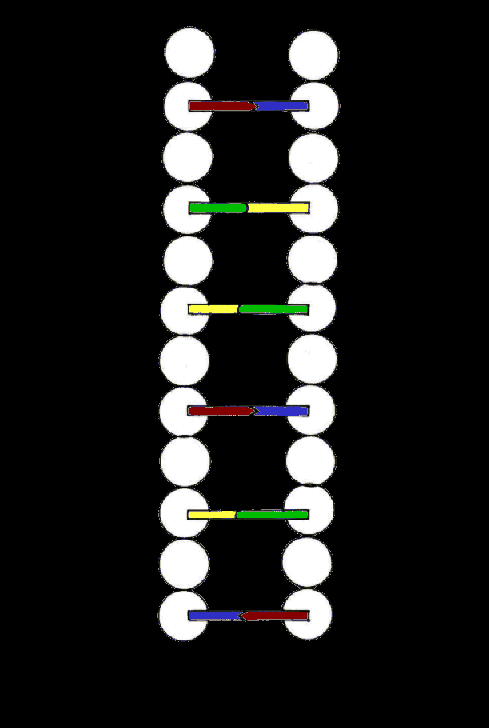
Here is a short video I made years ago of replication.
How does the order of A, T, C, and Gs code for life?
This is where things get cooler and more complex. It is called Transcritption
Just one small section of the DNA gets unzipped (studying what determines this unzipping is called epigenetics and is a growing and fascinating field). The strand that binds with it is RNA, so it is stable as a single strand. This single strand of RNA drifts out of the nucleus (endoplasmic reticulum) and the ribosomes use the sequence to make proteins. Take a look:

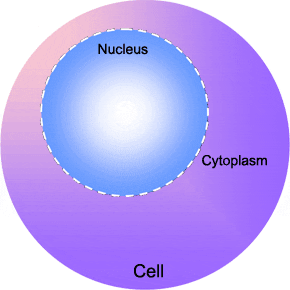
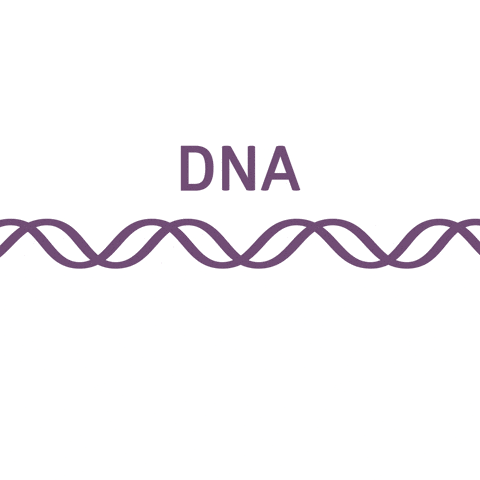

Notice in the RNA, that there are no Ts. Instead, they are replaced with Us (Uracil). This is not terribly important at this level of understanding, but just something to notice.
Once you have this messenger RNA code, it has to get translated into a protein. This happens in the ribosomes:

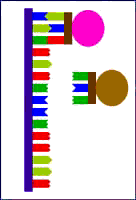
Notice that there are three bases that code for each protein. This is called the "codon."
It took years, but they finally cracked the code for which codons make which proteins. You DO NOT need to know this, but it is so cool, I wanted to share it:
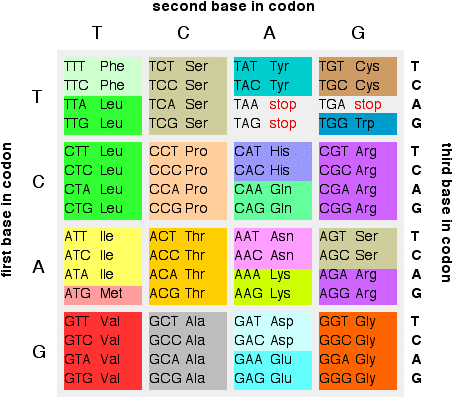
The words are abbreviations for the 20 amino acids that make up proteins.
This is how the code makes proteins.
Mutations:
A mutation is a sudden change in the structure of DNA
This is the ultimate source of all genetic variety for evolution
Most mutations have little or no effect on the organism
Some mutations are harmful and usually result in the cell's death
A few mutations result in a difference that could be beneficial in the right environment --> evolution
Anything known to cause a mutation is called a mutagen
The first organism showing a genetic trait in their cells is called a mutant
How could an organism get a mutation in every cell?
It has to have the sperm, egg, or zygote mutated. If one of your arm cells mutates, it cannot get that mutation in your other cells.
Types of mutations:
Point mutations - changes in one base in the whole DNA sequence.
You can have the relatively harmless substitution where an A becomes a G or something. This often makes one amino acid in a protein of 20,000 amino acids different and therefore makes little difference. Sometimes the new protein is a little better or a little worse, but nothing drastic.
You can have a deletion where a base goes missing. This shifts all the rest of the bases and messes up all the amino acids from the mutation on downward.
You can have an insertion where an extra base gets put in. This also shifts all the rest of the bases and messes up all the amino acids from the mutation on downward.
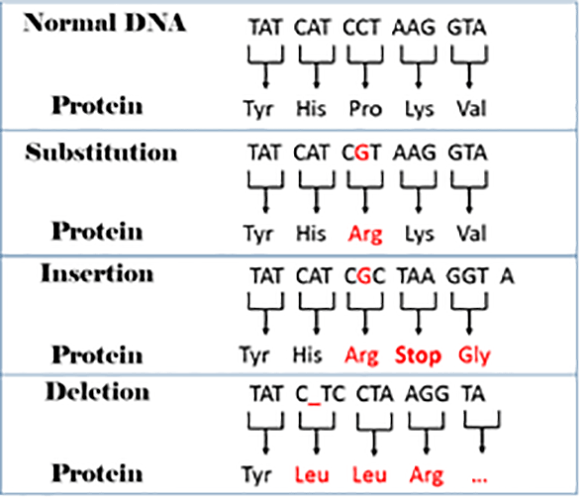
Some mutations occur during meiosis and mitosis. Remember the DNA binds up during prophase to prevent tangling and ripping of the strand during separation, but sometimes ripping happens anyway. When this happens, whole sections of DNA with many genes on it can be altered. These are called chromosomal mutations:
Once again, you can have substitutions. insertions, and deletions of whole sections of DNA. You also can have sections inverted and translocated to other chromosomes. There is even non-disjuncture where the chromosomes don't separate during meiosis resulting in one cell having too many entire chromosomes and the other having too few.
Nondisjuncture

Nondisjunction is a mutation that results in a whole chromosome missing or extra. Life is too fragile to thrive with either too many or too few chromosomes. Having an extra chromosome 21 results in down syndrome. Having an extra X chromosome results in Klinefelter's syndrome. Having an extra Y results in an XYY male. Having only one X chromosome results in Turner's syndrome. Most other nondisjunction result in death in humans.
But plants can take many copies of their chromosomes. Indeed, some organisms can live with double or triple or even quadruple the complement of chromosomes. These are called polyploidy and that means that they have multiple copies of their genes. All your cells are diploid except gametes which are haploid. Those enormous strawberries you enjoy are polyploidy with sometimes 5 times the DNA of a natural strawberry.
Focus questions to ensure you paid attention to the important things on this page:
What are the parts (structure) of DNA?
Which bases pair with which bases?
How does DNA replicate?
Briefly describe transcription.
Briefly describe translation.
What is a mutation?
List some types of mutations.
Where would a mutation have the greatest affect?